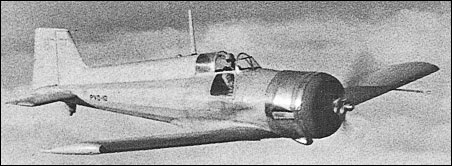|
| Fundamentally a redesigned and improved Type 151 Jockey and, indeed, initially known as the Jockey II, the Type 279, for which Vickers adopted the name Venom, was intended to meet the requirements of Specification F.5/34. Powered by a 625hp Bristol Aquila AE.3S nine-cylinder sleeve-valve radial engine enclosed by a long-chord NACA cowling, the Venom was a highly sophisticated aircraft, with a metal monocoque fuselage, its stressed skin being affixed by countersunk rivets. It was unique at the time it entered flight test, on 17 June 1936, in having 90°-deflection flaps. The Venom retained the sideways-hinging engine feature of the Type 151, and a battery of eight 7.7mm machine guns was mounted in the wings from the start of test flying. The Venom proved exceptionally manoeuvrable, with outstanding roll rate and turning radius, but it lacked the power to compete seriously with its Rolls-Royce liquid-cooled Vee-type-engined contemporaries, and, as no sufficiently compact British air-cooled radial of adequate power was available for installation, it was scrapped in 1939.
 | A three-view drawing (1280 x 914) |
| WEIGHTS |
| Take-off weight | 1885 kg | 4156 lb |
| DIMENSIONS |
| Wingspan | 9.98 m | 33 ft 9 in |
| Length | 7.36 m | 24 ft 2 in |
| Height | 3.27 m | 11 ft 9 in |
| Wing area | 13.56 m2 | 145.96 sq ft |
| PERFORMANCE |
| Max. speed | 502 km/h | 312 mph |
| Ceiling | 9755 m | 32000 ft |
| Richard Crapp, e-mail, 16.12.2014 17:47 I am looking for proof that the aircraft carried guns.
I think I have every photo of the Venom and none show gun ports but also do not show wing service hatches so they may be faded out in the prints. All the text I have read mentions guns and one mentions wrinkles round the hatches but I need a photo? reply | | Steve Round, e-mail, 02.10.2013 05:22 Read about the conflict between Roy Feddon the chief designer of all pre-war and wartime Bristol engines and the owners of Bristol Aviation and then the mystery is solved and everything falls into place The owners of Bristol Aviation were radically inbred morons who couldn't chew gum and walk at the same time take a look around - we still have plenty of them running british industries. reply | | choqing, 20.06.2011 12:51 A 14 cylinder development of the aquila dit exist! It could have been a class of its own. The engine I refer to is the Taurus. reply | | sorland, e-mail, 01.11.2010 10:58 Gnome-Rhone 14m would be an obvious choice. If the Brits would allow a French engine. Same area as Aquila, a bit heavier, but 660 hp. I wonder if the quoted takeoff weight is with weapons and ammo. reply | |
| | David Powell, e-mail, 06.10.2009 22:41 Heh, too bad they didn't have the Centaurus engine in 1939!
Sounds similar to the Germans in conecpt, where they looked for a backup design that used a radial to complement the Messerschmitt 109 - and they ended up with the Focke Wulf 190.
Could they have used radials like the Short Sunderland used? reply | | Pure, e-mail, 11.04.2008 12:47 Alas! the taurus was only ever used by two aircraft as far as I am aware - Beaufort and Albacore torpedo bombers - and was never really developed. Perhaps a Twin Wasp might have been a better idea? reply | | roy dutch, e-mail, 04.10.2007 14:06 possibly good but not good enough to rival the spitfire reply | | Hedrikus Neticus, e-mail, 14.02.2007 22:45 Why was there no compact radial? A 14 cylinder development of the aquila dit exist! It could have been a class of its own. The engine I refer to is the Taurus.
An english mistery?
Hendricus Neticus
reply | | Hedrikus Neticus, e-mail, 14.02.2007 22:45 Why was there no compact radial? A 14 cylinder development of the aquila dit exist! It could have been a class of its own. The engine I refer to is the Taurus.
An english mistery?
Hendricus Neticus
reply |
|
Do you have any comments?
|
| 
COMPANY
PROFILE
All the World's Rotorcraft
|








